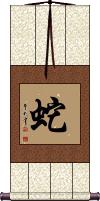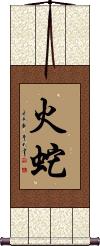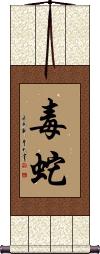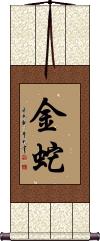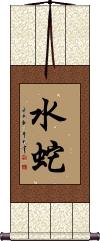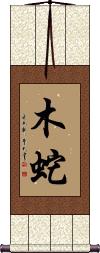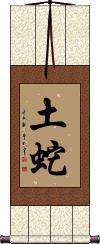Many custom options...
And formats...

Serpent in Chinese / Japanese...
Buy a Serpent calligraphy wall scroll here!
Personalize your custom “Serpent” project by clicking the button next to your favorite “Serpent” title below...
2. Fire Snake
3. Ophiuchus
4. Viper
6. Water Snake
7. Wood Snake
8. Fire Snake
9. Earth Snake
10. The Five Animals
Snake / Serpent
Year of the Snake / Zodiac Sign
蛇 is the character for snake or serpent in Chinese, old Korean, and Japanese.
If you were born in the year of the snake, you . . .
Are calm.
Are an inspiration to others.
Have a stubborn nature like a mule (you do not like to concede).
See also our Chinese Zodiac page.
Fire Snake
Ophiuchus Zodiac Symbol / Sign
蛇夫座 is the Chinese way to write Ophiuchus (the serpent bearer) of western astrology.
Please note this version is only used in Chinese (not Japanese).
See Also: Chinese Zodiac
Viper
Poisonous Snake
毒蛇 is the Chinese, Japanese Kanji, and old Korean Hanja for viper.
While 毒蛇 usually means viper, it may be used by some to refer to any poisonous snake or poisonous serpent.
Golden/Metal Snake
The Year of the Gold Snake
金蛇 is Golden/Metal Snake in Chinese.
In the Chinese zodiac and sexagenary (60-year) cycle, this combination occurs in years that include 1881, 1941, 2001, and 2061.
In the sexagenary cycle, this year is represented by 辛巳.
See Also: Snake
Water Snake
The Year of the Water Snake
水蛇 is Water Snake in Chinese.
In the Chinese zodiac and sexagenary (60-year) cycle, this combination occurs in years that include 1893, 1953, 2013, and 2073.
In the sexagenary cycle, this year is represented by 癸巳.
See Also: Snake
Wood Snake
The Year of the Wood Snake
木蛇 is Wood Snake in Chinese.
In the Chinese zodiac and sexagenary (60-year) cycle, this combination occurs in years that include 1905, 1965, 2025, and 2085.
In the sexagenary cycle, this year is represented by 乙巳.
See Also: Snake
Fire Snake
The Year of the Fire Snake
火蛇 is Fire Snake in Chinese.
In the Chinese zodiac and sexagenary (60-year) cycle, this combination occurs in years that include 1917, 1977, 2037, and 2097.
In the sexagenary cycle, this year is represented by 丁巳.
See Also: Snake
Earth Snake
The Year of the Earth Snake
土蛇 is Earth Snake in Chinese.
In the Chinese zodiac and sexagenary (60-year) cycle, this combination occurs in years that include 1869, 1929, 1989, and 2049.
In the sexagenary cycle, this year is represented by 己巳.
See Also: Snake
The Five Animals
Dragon Snake Tiger Leopard Crane
龍蛇虎豹鶴 is a list of the Chinese characters for the five animals of Shaolin Kung Fu in a comfortable order (meaning that they are in the proper order and will “feel right” to a Chinese person who views this arrangement).
The following table may be helpful for those studying Chinese or Japanese...
| Title | Characters | Romaji (Romanized Japanese) | Various forms of Romanized Chinese | |
| Snake Serpent | 蛇 | hebi | shé / she2 / she | |
| Fire Snake | 火蛇 | hi hebi / hihebi | huǒ shé / huo3 she2 / huo she / huoshe | |
| Ophiuchus Zodiac Symbol Sign | 蛇夫座 | shé fū zuò she2 fu1 zuo4 she fu zuo shefuzuo | she fu tso shefutso |
|
| Viper | 毒蛇 | doku hebi / dokuhebi | dú shé / du2 she2 / du she / dushe | tu she / tushe |
| Golden/Metal Snake | 金蛇 | jīn shé / jin1 she2 / jin she / jinshe | chin she / chinshe | |
| Water Snake | 水蛇 | shuǐ shé / shui3 she2 / shui she / shuishe | ||
| Wood Snake | 木蛇 | mù shé / mu4 she2 / mu she / mushe | ||
| Fire Snake | 火蛇 | huǒ shé / huo3 she2 / huo she / huoshe | ||
| Earth Snake | 土蛇 | tǔ shé / tu3 she2 / tu she / tushe | t`u she / tushe / tu she | |
| The Five Animals | 龍蛇虎豹鶴 龙蛇虎豹鹤 | ryuu hebi tora hyou tsuru ryuuhebitorahyoutsuru ryu hebi tora hyo tsuru | lóng shé hǔ bào hè long2 she2 hu3 bao4 he4 long she hu bao he longshehubaohe | lung she hu pao ho lungshehupaoho |
| In some entries above you will see that characters have different versions above and below a line. In these cases, the characters above the line are Traditional Chinese, while the ones below are Simplified Chinese. | ||||
Successful Chinese Character and Japanese Kanji calligraphy searches within the last few hours...
